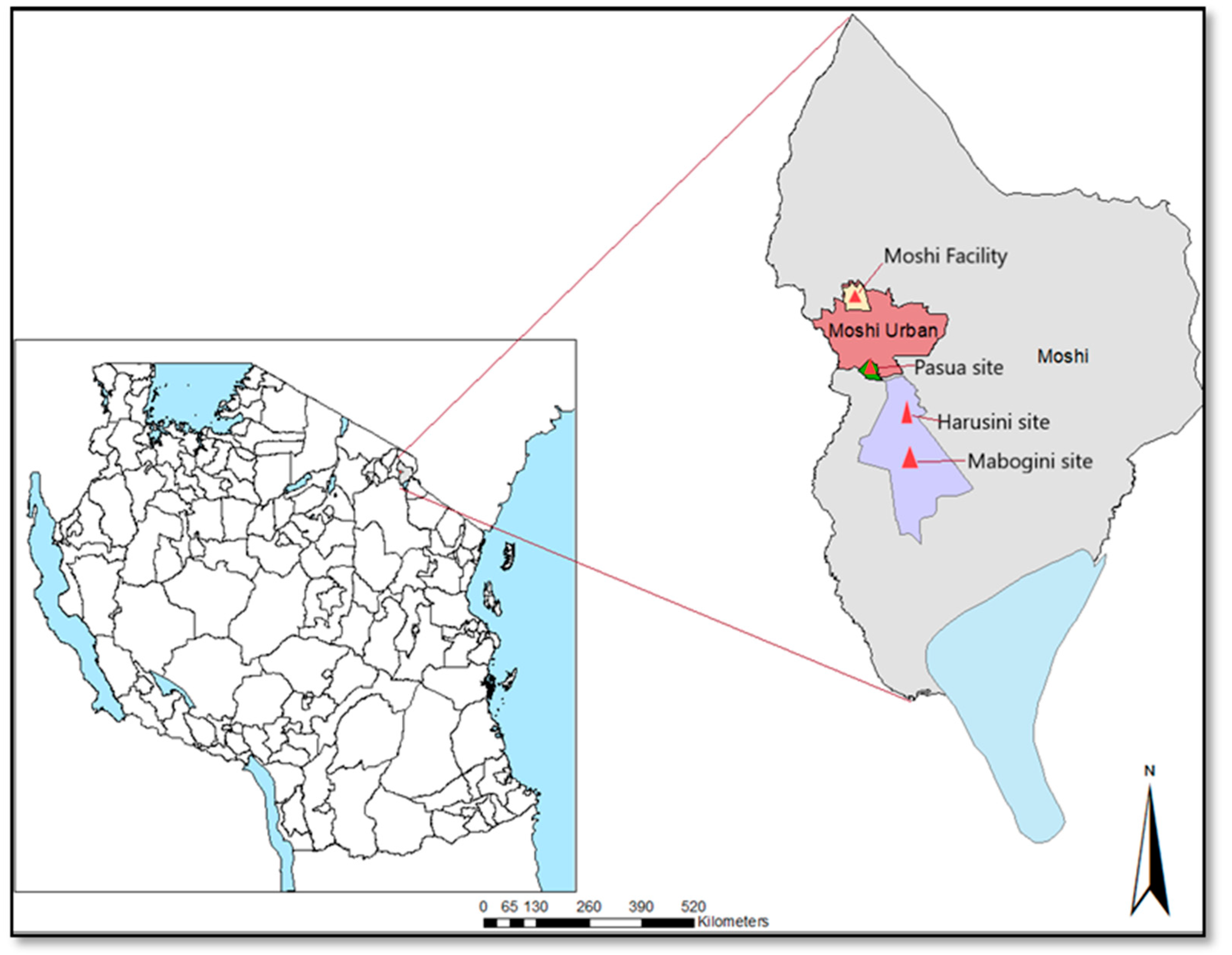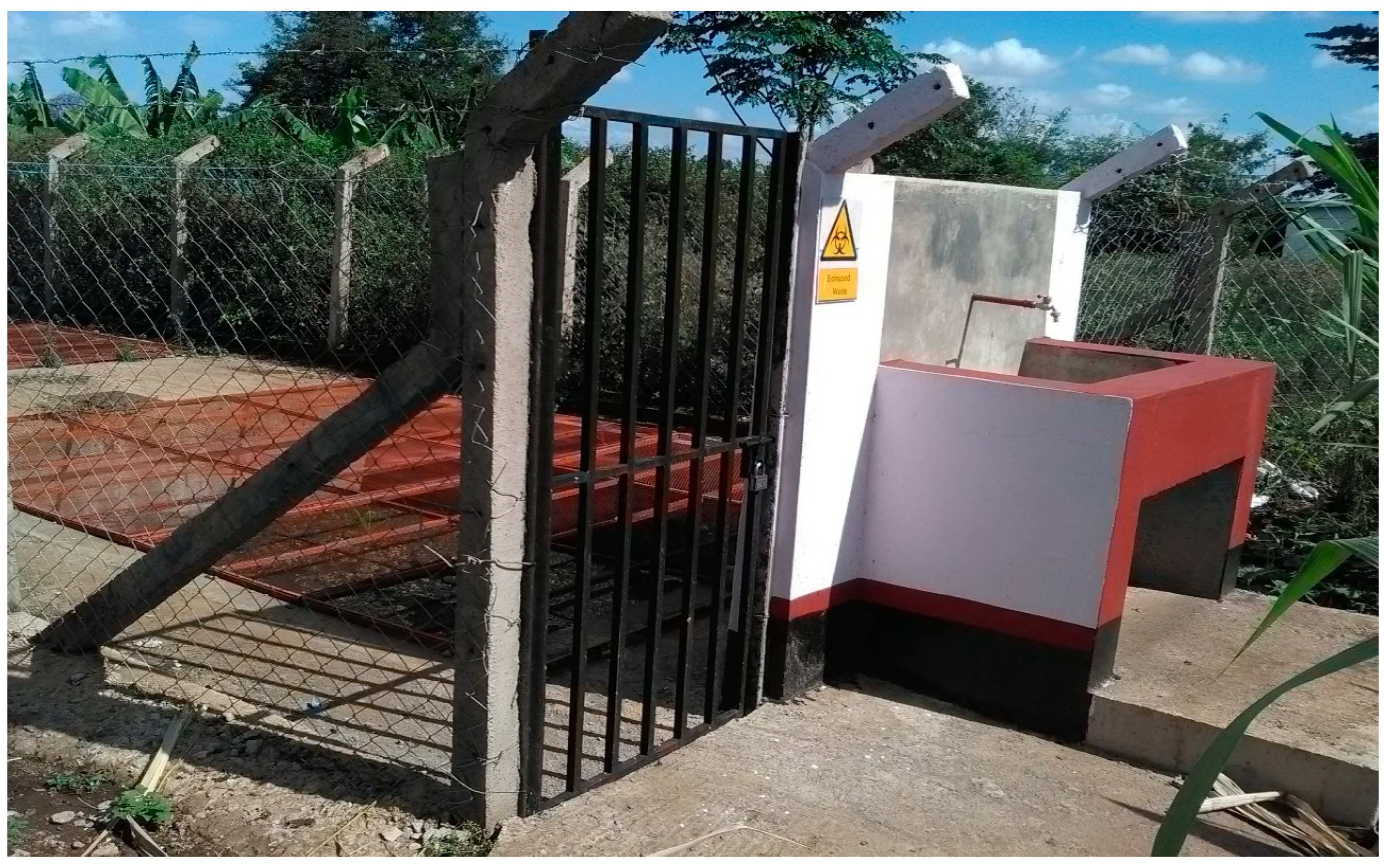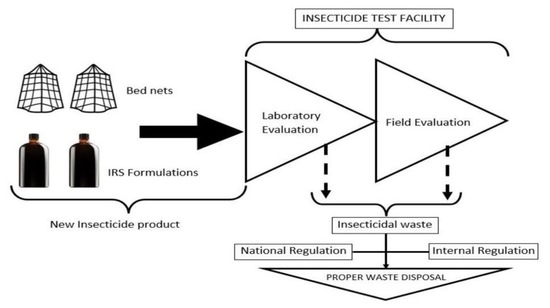Simplified Procedures for Managing Insecticidal Waste: A Case Report of KCMUCo-PAMVERC Vector Control Product Testing Facility in North-Eastern Tanzania
Abstract
1. Introduction
2. Materials and Methods
2.1. Study Site
2.2. Key Policies and Guidelines for Insecticidal Waste Management
2.3. Training and Internal Guidelines
2.4. Procedures for Insecticidal Waste Management
2.4.1. Facility Inspection by National Authority
2.4.2. Identifying Waste Generation Points and Developing a Management Plan
2.4.3. Categorization of Wastes Generated
2.4.4. Waste Packaging and Containment
2.4.5. Implementation of Solid and Liquid Hazardous Chemical Wastes Disposal
2.4.6. Internal and External Monitoring for Waste Management
2.5. Analysis of Waste Generation Index
3. Results
- i.
- Safety manual
- ii.
- Standard Operating Procedures (SOPs) on risk assessment, waste management and disposal, handling hazardous materials, health and safety procedures, and chemical usage.
4. Discussion
5. Conclusions
Author Contributions
Funding
Institutional Review Board Statement
Informed Consent Statement
Data Availability Statement
Acknowledgments
Conflicts of Interest
Abbreviations
| EMA | Environmental Management Act |
| GLP | Good Laboratory Practice |
| HPLC | High Performance Liquid Chromatography |
| IRS | Indoor Residual Spraying |
| KCMUCo | Kilimanjaro nChristian Medical Universtity College |
| LLINs | Long Lasting Insecticidal nets |
| NEAP | National Environmental Action Plan |
| NEMC | National Environmental Management Council |
| PAMVERC | Pan African Malaria Vector Research Consortium |
| SOPs | Standard Operating Procedures |
| WHO | World Health Organization |
References
- Lengeler, C. Insecticide-treated bed nets and curtains for preventing malaria. Cochrane Database Syst. Rev. 2004, 2, CD000363. [Google Scholar] [CrossRef]
- Pluess, B.; Tanser, F.C.; Lengeler, C.; Sharp, B.L. Indoor residual spraying for preventing malaria. Cochrane Database Syst. Rev. 2010, 2010, CD006657. [Google Scholar] [CrossRef]
- Lees, R.; Praulins, G.; Davies, R.; Brown, F.; Parsons, G.; White, A.; Ranson, H.; Small, G.; Malone, D. A testing cascade to identify repurposed insecticides for next-generation vector control tools: Screening a panel of chemistries with novel modes of action against a malaria vector. Gates Open Res. 2019, 3, 1464. [Google Scholar] [CrossRef] [PubMed]
- Felsot, A.S.; Racke, K.D.; Hamilton, D.J. Disposal and degradation of pesticide waste. Rev. Environ. Contam. Toxicol. 2003, 177, 123–200. [Google Scholar] [CrossRef] [PubMed]
- Matthews, G.; Zaim, M.; Yadav, R.S.; Soares, A.; Hii, J.; Ameneshewa, B.; Mnzava, A.; Dash, A.P.; Ejov, M.; Tan, S.H.; et al. Status of legislation and regulatory control of public health pesticides in countries endemic with or at risk of major vector-borne diseases. Environ. Health Perspect. 2011, 11, 1517–1522. [Google Scholar] [CrossRef] [PubMed]
- Loha, K.M.; Lamoree, M.; Weiss, J.M.; de Boer, J. Import, Disposal, and Health Impacts of Pesticides in the East Africa Rift (EAR) Zone: A Review on Management and Policy Analysis. Crop Prot. 2018, 112, 322–331. [Google Scholar] [CrossRef]
- Agenda. A Case Study on Trade and Utilization of Pesticides in Tanzania: Implication to Stockpiling. Final Report, Dar-es-Salaam, Tanzania. 2006. Available online: http://www.panuk.org/archive/Projects/Obsolete/14.%20Babati%20Case%20Study_Tanzania.pdf (accessed on 19 February 2022).
- TPRI. Registered Plant Protection Substances for Use in the United Republic of Tanzania; Tropical Pesticides Research Institute, Ministry of Agriculture, Livestock and Fisheries: Arusha, Tanzania, 2015. [Google Scholar]
- Bradberry, S.M.; Cage, S.A.; Proudfoot, A.T.; Vale, J.A. Poisoning due to pyrethroids. Toxicol. Rev. 2005, 24, 93–106. [Google Scholar] [CrossRef] [PubMed]
- Ware, G. Reviews of Environmental Contamination and Toxicology: Continuation of Residue Reviews, 1990th ed.; Springer: New York, NY, USA, 1989. [Google Scholar]
- Antwi, F.B.; Reddy, G.V. Toxicological effects of pyrethroids on non-target aquatic insects. Environ. Toxicol. Pharmacol. 2015, 40, 915–923. [Google Scholar] [CrossRef] [PubMed]
- Food and Agriculture Organization. Guidelines on Management Options for Empty Pesticide Containers. 2008. Available online: https://www.fao.org/fileadmin/templates/agphome/documents/Pests_Pesticides/Code/Containers08.pdf (accessed on 19 January 2022).
- FAO. Environmental Management Tool Kit for Obsolete Pesticides; Food and Agriculture Organization: Geneva, Switzerland, 2020; Available online: https://www.fao.org/fileadmin/templates/obsolete_pesticides/Guidelines/EMTK4xweb_nov_small.pdf (accessed on 19 January 2022).
- Malisa, A. Situation, Challenges and Plans for Environment Statistics in Tanzania. 2007. Available online: https://unstats.un.org/unsd/ENVIRONMENT/envpdf/UNSD_UNEP_ECA%20Workshop/Tanzania.pdf (accessed on 19 February 2022).
- NEMC. The National Environmental Research Agenda for Tanzania 2017–2022. National Environmental Management Council of Tanzania. 2017. Available online: https://www.nemc.or.tz/uploads/publications/sw-1576226565 (accessed on 19 February 2022).
- Weiss, E.B. United Nations conference on environment and development. Int. Leg. Mater. 1992, 31, 814–817. [Google Scholar] [CrossRef]
- KCMU College-PAMVERC. Pan-African Malaria Vector Research Consortium (PAMVERC). 2021. Available online: https://pamverc.or.tz/indexs.php?pamvercdataset=pamverc_research (accessed on 19 February 2022).
- Begg, S.; Wright, A.; Small, G.; Mosha, F.; Kirby, M.; Snetselaar, J.; Aziz, S.; Bharmal, J.; Dacombe, R.; Bates, I. Developing laboratory capacity for Good Laboratory Practice certification: Lessons from a Tanzanian insecticide testing facility. Gates Open Res. 2020, 12, 4–59. [Google Scholar] [CrossRef] [PubMed]
- Pallagyo, D.M. Environmental law in Tanzania; How far have we gone. Law Env’t Dev. J. 2007, 3, 26. [Google Scholar]
- NEMC. The Environmental Management Act. Available online: https://www.nemc.or.tz/uploads/publications/sw-1576228517-ema%20act2004.pdf. (accessed on 19 January 2022).
- UNEP Ozone Secretariat. Montreal Protocol—Achievements to Date and Challenges Ahead. United Nations Environmental Program. 2015. Available online: http://42functions.net/en/MP_achievements_challenges.php (accessed on 19 February 2022).
- Sundram, M.S. Basel Convention on Transboundary Movement of Hazardous Wastes: Total Ban Amendment. Pace Int’l L. Rev. 1997, 9, 1. Available online: http://digitalcommons.pace.edu/pilr/vol9/iss1/1 (accessed on 19 January 2022).
- Ovink, B.J. Transboundary shipments of toxic waste: The Basel and Bamako Conventions: Do Third World countries have a choice. Dick. J. Int’l L. 1994, 13, 281. [Google Scholar]
- OECD. Series on Principles of Good Laboratory Practice (GLP) and Compliance Monitoring—OECD. 2022. Available online: https://www.oecd.org/chemicalsafety/testing/oecdseriesonprinciplesofgoodlaboratorypracticeglpandcompliancemonitoring.htm. (accessed on 10 January 2022).
- Kennedy, M.V.; Stojanovic, B.J.; Shuman, F.L., Jr. Chemical and thermal methods for disposal of pesticides. Residue Rev. 1969, 29, 89–104. [Google Scholar] [CrossRef] [PubMed]
- Leonelli, P.; Bovincini, S.; Spadoni, G. Hazardous Materials Transportation: A Risk-Analysis-Based Routing Methodology. J. Hazard Mater. 2000, 71, 283–300. [Google Scholar] [CrossRef]
- Hu, J.; Shang, R.; Heijman, B.; Rietveld, L. Reuse of spent granular activated carbon for organic micro-pollutant removal from treated wastewater. J. Environ. Manag. 2015, 1, 98–104. [Google Scholar] [CrossRef] [PubMed]
- Omoregie, M.J.; Odibi, T.I. Design and fabrication of a domestic incinerator. J. Appl. Sci. Environ Manag. 2017, 21, 981. [Google Scholar] [CrossRef][Green Version]
- World Health Organization. Guidelines for Testing Mosquito Adulticides for Indoor Residual Spraying and Treatment of Mosquito Nets. 2006. World Health Organization. Available online: https://apps.who.int/iris/handle/10665/69296 (accessed on 10 January 2022).
- WHO. Guidelines for Laboratory and Field-Testing of Long-Lasting Insecticidal Nets; WHO/HTM/NTD/WHOPES/2013.3; WHO: Geneva, Switzerland, 2013. [Google Scholar]
- FAO. FAO Requires Financial Support for the Disposal of Obsolete Pesticides in Africa and the Near East; Food and Agriculture Organization: Geneva, Switzerland, 2022; Available online: https://www.fao.org/NEWS/1998/980307-e.htm (accessed on 19 May 2022).
- Velzy, C.; Feldman, J.; Trichon, M. Incineration technology for managing biomedical wastes. Waste Manag. Res. 1990, 8, 293–298. [Google Scholar] [CrossRef]
- Singh, B.K.; Walker, A. Microbial degradation of organophosphorus compounds. FEMS Microbiol. Rev. 2006, 30, 428–471. [Google Scholar] [CrossRef] [PubMed]
- Hlihor, R.M.; Gavrilescu, M.; Tavares, T.; Favier, L.; Olivieri, G. Bioremediation: An Overview on Current Practices, Advances, and New Perspectives in Environmental Pollution Treatment. Biomed. Res. Int. 2017, 2017, 6327610. [Google Scholar] [CrossRef]






| Source of Waste | Liquid Waste in Cubic Meters (95% CI) | Solid Waste in Tonnes (95% CI) |
|---|---|---|
| Phase I and II IRS | 0.088 (0.069–0.106) | 6.3 (1.4–11.2) |
| Phase I LLIN | 0.020 (0–0.058) | 0 |
| Phase II LLIN | 24.857 (14.720–34.994) | 0 |
| Other sources * | 0.117 (0.110–0.125) | 0 |
| Study Phase | Typical Liquid Waste | Typical Solid Waste |
|---|---|---|
| Phase I IRS | Water from washing of potter spraying tower | Expired insecticide-treated substrates (blocks) |
| Phase II IRS | Water from washing of compression sprayers | Sand chippings from treated experimental hut walls |
| Phase I LLINs | Water from washing of LLINs pieces, washing of insecticide-treated blanket pieces | Expired LLINs and insecticide-treated blankets pieces |
| Phase II LLINs | Water from washing of whole LLINs, washing of whole insecticide-treated blankets | Expired LLINs and insecticide-treated blankets |
| Others | Expired laboratory reagents, insecticide-contaminated water from washing the Potter tower and laboratory re-usable such as Wheaton bottles, expired stock, and working insecticidal solutions |
Publisher’s Note: MDPI stays neutral with regard to jurisdictional claims in published maps and institutional affiliations. |
© 2022 by the authors. Licensee MDPI, Basel, Switzerland. This article is an open access article distributed under the terms and conditions of the Creative Commons Attribution (CC BY) license (https://creativecommons.org/licenses/by/4.0/).
Share and Cite
Msapalla, A.; Azizi, S.; Jangu, M.; Mbewe, N.J.; Matowo, J.; Shayo, M.F.; Kaaya, R.; Mawa, B.; Joram, A.; Kirby, M.J.; et al. Simplified Procedures for Managing Insecticidal Waste: A Case Report of KCMUCo-PAMVERC Vector Control Product Testing Facility in North-Eastern Tanzania. Environments 2022, 9, 65. https://doi.org/10.3390/environments9060065
Msapalla A, Azizi S, Jangu M, Mbewe NJ, Matowo J, Shayo MF, Kaaya R, Mawa B, Joram A, Kirby MJ, et al. Simplified Procedures for Managing Insecticidal Waste: A Case Report of KCMUCo-PAMVERC Vector Control Product Testing Facility in North-Eastern Tanzania. Environments. 2022; 9(6):65. https://doi.org/10.3390/environments9060065
Chicago/Turabian StyleMsapalla, Agness, Salum Azizi, Menan Jangu, Njelembo J. Mbewe, Johnson Matowo, Magreth F. Shayo, Robert Kaaya, Benson Mawa, Amandus Joram, Mathew J. Kirby, and et al. 2022. "Simplified Procedures for Managing Insecticidal Waste: A Case Report of KCMUCo-PAMVERC Vector Control Product Testing Facility in North-Eastern Tanzania" Environments 9, no. 6: 65. https://doi.org/10.3390/environments9060065
APA StyleMsapalla, A., Azizi, S., Jangu, M., Mbewe, N. J., Matowo, J., Shayo, M. F., Kaaya, R., Mawa, B., Joram, A., Kirby, M. J., Rowland, M. W., & Mosha, F. (2022). Simplified Procedures for Managing Insecticidal Waste: A Case Report of KCMUCo-PAMVERC Vector Control Product Testing Facility in North-Eastern Tanzania. Environments, 9(6), 65. https://doi.org/10.3390/environments9060065







